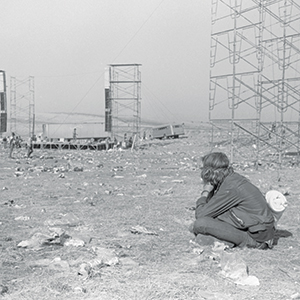Features & Columns
Joel Selvin's New Book Re-Explores
Altamont Tragedy, Rock Egos
truths about the infamous 1969 Altamont concert.
 Inspired by recent conversations, Joel Selvin set out to learn new truths about the infamous 1969 Altamont concert.
Inspired by recent conversations, Joel Selvin set out to learn new truths about the infamous 1969 Altamont concert.
In Joel Selvin's new book, Altamont: The Rolling Stones, the Hells Angels, and the Inside Story of Rock's Darkest Day, the veteran music journalist effectively dismantles common narratives behind the infamous December 1969 free concert at Altamont Speedway, where Hells Angels were paid $500 in beer to act as security and wound up beating people with pool cues.
One of the Angels knifed and killed a person, Meredith Hunter, although he was eventually acquitted.
The version of the story put forth by the film Gimme Shelter conveniently absolved the Stones, but not their manager, while also unequivocally blaming the Hells Angels and leaving everything else to chance. Over the decades, this narrative became the accepted version of the events. Turns out the film, while still one of the greatest rock documentaries ever made, did not even remotely capture what happened that day or the many moving parts that led up to the tragic final night.
Over the decades, Selvin has unearthed a landmine of details while maintaining a back-burner network of sources on the whole sordid mess. When former Stones tour manager Sam Cutler came to Santa Clara for a 2013 appearance at Studio Bongiorno, promoting his own memoir of those days, Selvin joined him on stage and the two yakked for at least an hour. It was an amazing night. From there, the book began to crystalize.
"We spent the evening plumbing [Cutler's] recollections of the event almost as if the audience wasn't there," Selvin writes. "By that time, I had already been considering this book and started collecting research, but listening to Sam that night helped me realize just how much of a story was there."
As a result, the book reads like a true crime story. It was the Grateful Dead who organized the show, at least in the beginning. The initial idea was to stage a free concert in Golden Gate Park with the Dead and Jefferson Airplane. The Stones were only to be announced the day beforehand. Since the Dead and the Airplane regularly played impromptu free gigs in the Panhandle area, and since the West Coast wanted its own Woodstock, such a scheme made sense. At first.
But as the Stones 1969 tour unfolded and the band's brain trust and operating machinery became more bloated, illegal and uncontrollable—and while the filmmakers continued to document the whole circus—the writing should have appeared on the wall. From the beginning of the tour, since Mick Jagger hated cops, he refused to allow any uniformed policemen inside the venues. This was written into the contracts with promoters.
Meanwhile, on the home front, after a mysterious person acting as the Stones' liaison botched the Golden Gate Park negotiations, the venue was moved to Sears Point Raceway, a perfect location with freeway access and a large hill for the stage. But when the owners of Sears Point demanded all distribution rights for the film, Jagger refused. So another venue had to be found, not even two days ahead of the concert. Jagger was prioritizing the film project and orchestrating a grand-scale conclusion to the tour, just for the film's sake.
Plenty of other backstories appear in Selvin's book. In one passage resembling an episode of the Andy Griffith Show, we get a glimpse at two rural cops from the only backwater substation remotely close to Altamont, both of them scrambling to comprehend a few hundred thousand wasted hippies descending on the desolate countryside east of Livermore. You can almost hear banjos while reading the pages.
In other passages, Selvin goes out of his way to corroborate Jerry Garcia's claim that the wannabe-Hells Angels and hangers-on from San Jose are the ones who ruined everything. "Prospects" are prospective Hells Angels, the aspiring members, the ones who set up chairs at meetings and stuff like that. Selvin writes that prospects from San Jose followed along to join the fracas and it was they who acted the worst. This is in addition to the San Jose Hells Angel who killed Meredith Hunter.
In the end, Selvin arrives at some very brave but logical conclusions. He lays serious blame at the feet of specific individuals, although I'd be a poor boy to spoil it for you. And there's just no place for that.


